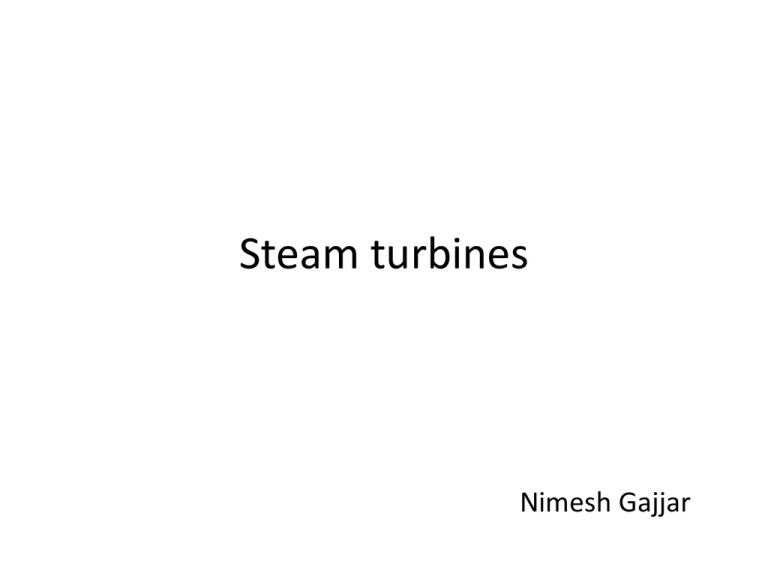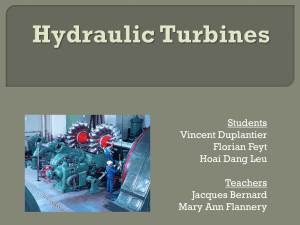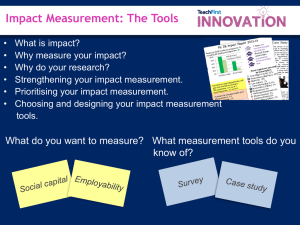Steam Turbines
advertisement

Steam turbines Nimesh Gajjar What exactly is the turbine? Turbine is an engine that converts energy of fluid into mechanical energy The steam turbine is steam driven rotary engine. Physical Principles: Steam Turbines: • High Pressure Steam expands through a governor valve and a nozzle. • Experiences an increase in velocity and momentum • Pushes the impeller to drive the turbine. http://home.pacifier.com/~rboggs/HP.GIF 3 Principle & Types of Steam Turbine. • Types Impulse Turbine. Reaction Turbine. • Principle: when steam is allowed to expand through a narrow orifice, it assumes kinetic energy at the expense of its enthalpy (heat energy). This kinetic energy of steam is changed to mechanical (rotational) energy through the impact (impulse) or reaction of steam against the blades. Construction of steam turbines Construction of steam turbines Classification of steam turbines a) way of energy conversion - impulse turbines - reaction turbines Classification of steam turbines b) flow direction - axial - radial c) number of stages - single stage - multi-stage Classification of steam turbines d) rotational speed - regular - low-speed - high-speed e) inlet steam pressure - high pressure (p>6,5MPa) - intermediate pressure(2,5MPa <p<6,5MPa) - low-pressure (p<2,5MPa) Classification of steam turbines f) way of energy utilisation - condensing - extraction - back-pressure Turbine Types condenser Straight-flow condensing process Back-pressure Turbine Types One section Two sections Types of Turbine Reheat turbine Types of Turbine Extraction turbine Classification of steam turbines g) application - power station - industrial - transport How does the steam turbine work? • • Impulse stage – whole pressure drop in nozzle (whole enthalpy drop is changed into kinetic energy in the nozzle) Reaction stage – pressure drop both in stationary blades and in rotary blades (enthalpy drop changed into kinetic energy both in stationary blades and in the moving blades in rotor) Single Stage Impulse Turbine IMPLUSE STAGE • • • Nozzles Blades Velocity • It is usually called De-Laval turbine The steam is fed through one or several convergent-divergent nozzles The nozzles do not extend completely around the circumference of the rotor, so that only part of the blades are impinged upon by the steam. Pressure drop occurs in the nozzle and not in the blades. Maximum velocity and hence kinetic energy of the steam occurs at the nozzle exit Velocity change occurs in the rotor blades where the steam gives up its energy to the rotor blades. Pressure • • Impulse Stage Compounded Steam Turbines • Compounded steam turbine means multistage turbine. • Compounding is needed when large enthalpy drop is available. • Since optimum blade speed is related to the exit nozzle speed. It will be higher as the enthalpy drop is higher. • The blade speed is limited by the centrifugal force as well as needs of bulky reduction gear • Compounding can be achieved either by velocity compounded turbine or pressure compounded turbine. Velocity Compounded Impulse Turbine • The velocity compounded turbine was first proposed by C.G Curtis. • It is composed of one stage of nozzles, as the single stage turbine, followed by two rows of moving blades instead of one. • These two rows are separated by one row of fixed blades which has the function of redirecting the steam leaving the first row of the moving blades to the second row of moving blades. Velocity Compounded Impulse Turbine (Contd.) Velocity-compounded Stage Pressure Compounding Impulse Turbine (Contd.) Two Stages Pressure Compounding Turbine Three Stages Pressure Compounding Turbine Pressure-compounded Stage Pressure-velocity Compounded Turbine Reaction Principle • Reaction effect results from issuing a fluid at very high velocity from a nozzle. This results in a reaction which moves the nozzle in the opposite direction. F mV o • Pure reaction happens if the flow is accelerated from zero velocity to its exist velocity in the moving blades. • Since this is not the case in turbines, thus there are no pure reaction turbine but it is usually a mix between impulse and reaction. Accordingly the term reaction turbine does not mean a full reaction turbine but a partially impulse and partially reaction. Reaction Turbine Reaction Turbine • • • • Reaction turbine has been invented by C.A. Parson Turbine with 50% reaction is the turbine where 50% of the enthalpy drop happens in the stator and the other 50% occurs in the rotor. It is important to mention that this does not mean equal pressure drops. Pressure drop is usually higher for the fixed blades and greater for the high pressure conditions, where the pressure drop per unit of enthalpy drop is higher at the high pressure The rotor blades of a reaction turbine are not symmetrical as in the impulse turbine, they are similar to those of the stator but curved in the opposite direction. Compounding Velocity Compounded Impulse Turbine (Contd.) Pressure Compounding Impulse Turbine (Contd.) Two Stages Pressure Compounding Turbine Three Stages Pressure Compounding Turbine STEAM TURBINE Compounding Types of turbine • Impulse turbine – Steam expands in nozzles only – Steam pressure at the outlet side of the blade equals that at inlet side • Impulse – Reaction turbine – Steam expands in nozzles as well as it passes through blades – Steam pressure at the outlet side of the blade may be less than that at inlet side. Impulse Stage Velocity-compounded Stage Pressure-compounded Stage Pressure-velocity Compounded Turbine Reaction Turbine Impulse Turbine • A turbine that is driven by high velocity jets of water or steam from a nozzle directed on to vanes or buckets attached to a wheel. The resulting impulse (as described by Newton's second law of motion) spins the turbine and removes kinetic energy from the fluid flow. Reaction Turbine • A type of turbine that develops torque by reacting to the pressure or weight of a fluid; the operation of reaction turbines is described by Newton's third law of motion (action and reaction are equal and opposite). Comparison of Impulse & Reaction Turbine Comparison Between Velocity and Pressure Compounding Impulse Turbines Velocity Compounding Pressure Compounding Not equal velocity drop for each stage Equal velocity drop for each stage No pressure drop per stage Not equal pressure drop per stage Non equal power per stage Equal power per stage High friction losses due to high velocities Low friction losses due to reduced steam velocity Not recommended for more than two stages Recommended for multistage No problem with steam leak Larger steam leak Suitable for small turbines as well as only Suitable for large turbines for the first stage in large turbine Velocity Diagram F T Optimum Velocity Impulse Stage Optimum Velocity Velocity-compounded Stage where n is the number of stages If n = 2, P(1) : P(2) = 3:1. If n = 3, P(1) : P(2) : P(3) = 5:3:1. Therefore, n > 2 is not economically justified. Optimum Velocity Reaction Stage Maximum Efficiency Impulse Stage Reaction Stage Comparison of Stages Impulse Stage Comparison of Stages Two-stage velocity-compounded Impulse Stage Comparison of Stages Reaction Stage







